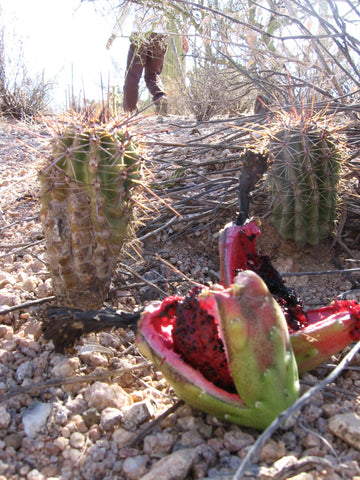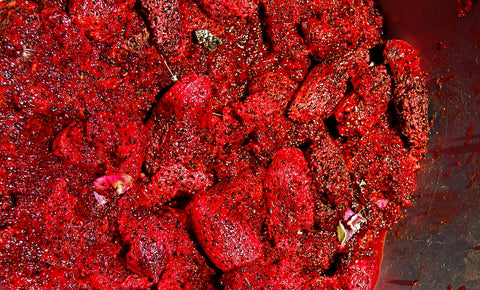Gathering Sonoran Sweetness
Gathering Sonoran Sweetness
The cherished time of year in the Sonoran desert is now upon us. While the desert heats up to temperatures above 110 F, many run for cooler, moister climes and foreign visitors are scorched in short time. This heat is necessary, it is a natural process inherent in our desert's ecology. To eliminate it in some way would be to lose one of the greatest gifts this desert has to offer us. Without the intense heat the fruit of our Saguaro cactus (Carnegiea gigantea) would not mature properly. Not many people today know the characteristic sweet taste of the fruit of the Saguaro cactus, known as bahidaj in the Tohono O'Odham (native peoples of the Sonoran desert region) language. It is the O'Odham people (often referred to as Papago) who have preserved the knowledge on how to prepare such things as Saguaro syrup (bahidaj sitol), Saguaro jelly, and Saguaro wine (navait).
Before the arrival of honey bees from Europe and Africa and processed sugar from refineries in the Caribbean, Saguaro, or haashan, fruit and syrup were the main natural sweeteners available to the people of the area surrounding Tucson. Traveling another 100 miles south, one begins to enter the terrain of the Organ Pipe cactus, or pitahaya, as it is known in Mexico, which also produces a very sweet edible fruit which can be processed into a natural syrup. These treasures were once coveted by all inhabitants of the desert - humans and animals, alike. The sweet flavor, as it is described in the Chinese cosmology, is cooling and moistening. What more could one look for during the hot & dry seasons of the Sonoran desert? It is a medicine in itself simply for this virtue. Long before the omnipresence of sweeteners in our diets, we would covet a natural sweet. Sugar or honey was said to bring a patient back from the dead in northern Africa. Even the most acclimatized desert dweller is affected by daily temperatures above 105 F with zero humidity. Understandably, worth more than gold to hunter-gatherer, agriculturalists seeking to live in harmony with their surroundings.
As the summer heats up the Saguaro fruit begin to ripen. First turning slightly red at the top the fruits soon burst open with the most luscious, deep purplish-red tone one can imagine, seducing man and woman alike with its sweet moistness. Now is the time for gathering. But if it should rain, 'it eats the fruit' as was said by the elders from past times. Moisture will cause the sugary liquid to quickly spoil in the hot sun. There are two basic methods for gathering the Saguaro fruit. 1) You can simply pick up whatever has fallen to the ground (gakidaj or joon), as all non-winged animals do, or 2) dis-lodge the mature fruit (bahidaj) from the top of the cactus. This may seem like a lot of work to someone who has not seen a good ku'ipad (see below) put to work. Well, it still may seem like a lot of work even after one has seen it, however, this is the main tool of the harvest. A ku'ipad is made up from the internal skeleton, or ribs, (vaapai) of the Saguaro. Two or more are spliced together with another rib, normally fastened together with baling wire. A cross piece (mastsig) is used near the top and fastened at an angle. This piece can be Mesquite as it is hard, and resists breaking.
Even the ripe fruits can be very resistant to coming off and often require some pushing (hemchkwua) or pulling force (od) to get them off the cactus. Putting it on at an angle makes a kind of hook for trapping the fruit before you pull on it. Once the fruit is knocked off, you can pick it up off the ground or have somebody there to catch it in a bucket or basket as was once done by the O'Odham. If you're making syrup, either way works fine. Any sand or plant debris picked up will be skimmed off or filtered when you cook it. If you find any fully dry fruit, save them separately. This joon, as it is called, is a most delicious treat and will keep fresh for over a year on the shelf. Combining it with other dry desert fruits and roasted wild seeds and nuts can make a fine Sonoran trail-mix. Traditionally, it was moistened and mixed into water to make a sweet drink - the original desert Gatorade.
Before boiling the fresh juicy fruit, water is added - "not too much, not too little". As it is being brought to a boil, it will begin to froth up. This froth is scooped up with a slotted spoon as it will carry the lighter plant debris up to the surface where it is easily skimmed and discarded. The heavier sand and pebbles will settle to the bottom. Once it has been sufficiently cleaned, it can be poured through a strainer to remove the seeds (kaai) and the fiber (kivc, "guts").
The seeds are stored away for later use. They were traditionally combined, ground, with wheat flour to make what's called ku'ul, and likely, before that, with ground corn, roasted, ground saltbush seeds, dry, ground cholla buds, pamita (Tansy Mustard)/ shuu'uvad seeds, etc., to make a gruel, or atol, or atole. The seeds were also used by nursing mothers as a galactagogue, perhaps as a nutritional aid. They were a food source which was nearly always on-hand. The fiber, or "guts," are separated from the seeds and used to make jelly combined with the juice. The fiber must contain pectin as it is used to "firm up" the juice into jelly, or jam.
Once the seeds are strained and the last bit of juice is poured off leaving the small stones and sand behind, one more fine straining is done before cooking off the remaining water. The added water must be cooked off in order to preserve the finished syrup; similar to honey's low water content which preserves it. The finished syrup can remain on the shelf for years when done properly, even once opened. Through time it may thicken and develop a consistency and strong flavor similar to rich molasses.
Haashan bahidaj harvest was once a major event in the life of the Tohono O'Odham people. Its significance so great as to mark the beginning of a new year when the harvest was complete and the navait prepared for another year-end celebration. There was song and there was dance done as the bahidaj sitol was set to ferment inside clay pots set into the warm ground for 4 days. This was a sacred time for them. As a people highly dependent upon the summer rains for their welfare and the continuance of their nation they must've put a lot into these ceremonies as calls for rain. A mindset which likely few of us have ever experienced in our lifetimes. Dependent upon, and completely at the mercy of Mother Nature and her blessings for us. In the harsh severity of the pre-monsoon Sonoran desert summer, the sweetness of the Saguaro peaked and the people let go of all restraint in their wine feast (goimeri) as if to induce the clouds to do the same.
There are many options on today's health food store shelves to improve your antioxidant intake, and none of them too inexpensive. Well, nature has to work hard to produce them! But think for a second about where mangosteen comes from, or acai, or green tea for that matter. All are from ecosystems thousands of miles away from our home in the Sonoran desert. Yet, we have a multitude of native plants producing fruit throughout the year which are high in potent antioxidants. Saguaro fruit is a rich natural sweetener, and, additionally, is super-rich in antioxidants. If you've ever seen acai paste it is a deep purple, not too dissimilar from bahidaj sitol . . . same as Elderberries, Prickly Pear fruit, Greythorn berries, Serviceberries, wild Raspberries, etc. . . . all strongly pigmented fruits, which equals high antioxidant content. If you want to limit free radical damage, help prevent cancer, improve digestion and micronutrient absorption, heal wounds rapidly, protect and heal the eyes, improve arterial elasticity, etc. increase antioxidant intake! It's all right here. Get out, get to know your environment, bring a friend, take a class on wild foods preparation and share it with your family. The ways which we can harmonize ourselves with our immediate environment are very simple, and profoundly healing for the body, mind and spirit.
(originally posted July 9, 2010)
References
Cross, Lambert Personal Communication, June-July, 2010.
Rea, Amadeo M. At the Desert's Green Edge, 1997.
Tucker, Stella Personal Communication, June, 2010.












QpbqcZNM
CoUamyVgdIKtz
LGSEsQvyWfUHABZa
nOKeXPZbCdLMTNB
wfUjIvFSzYGZE
Leave a comment